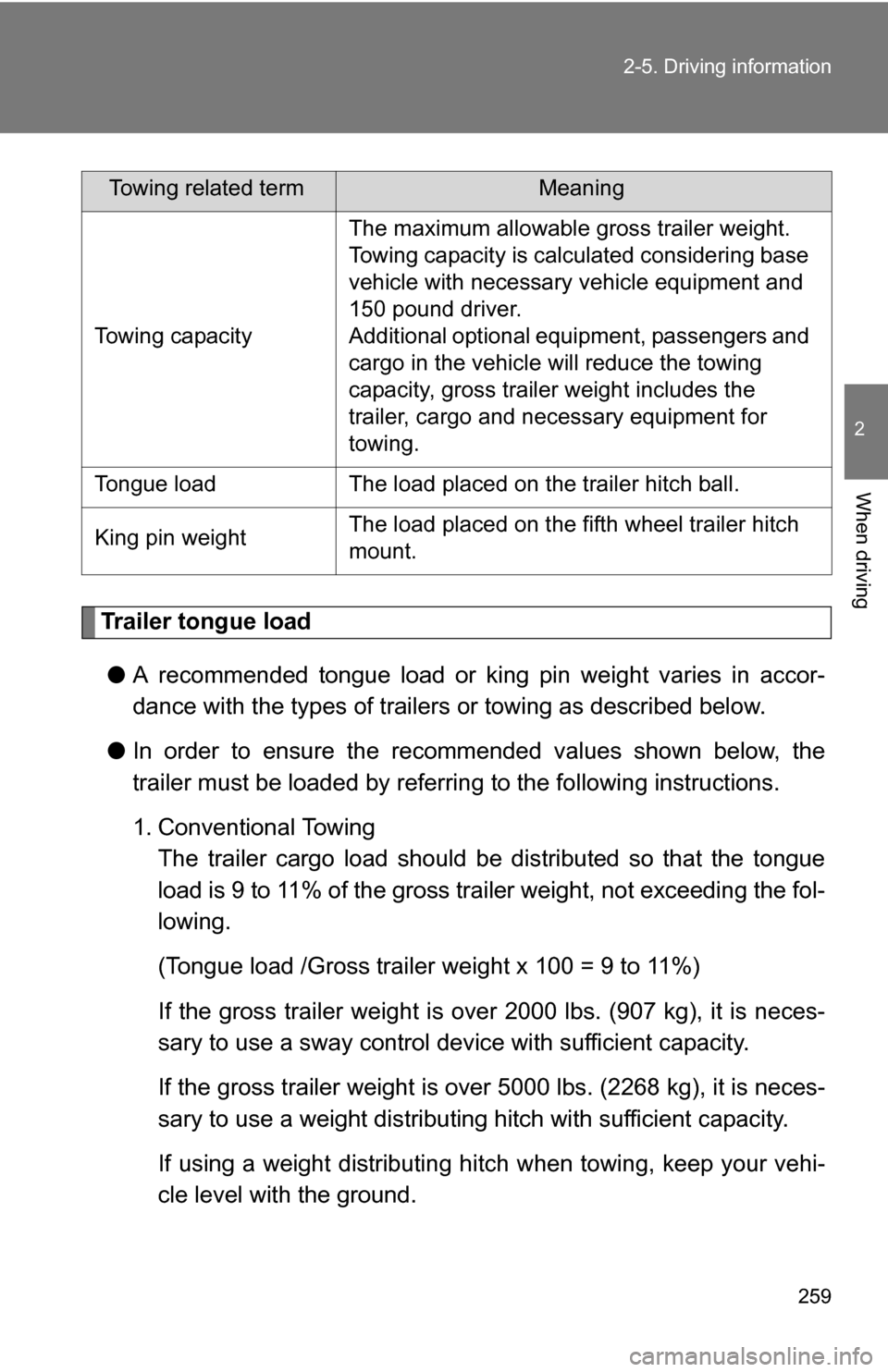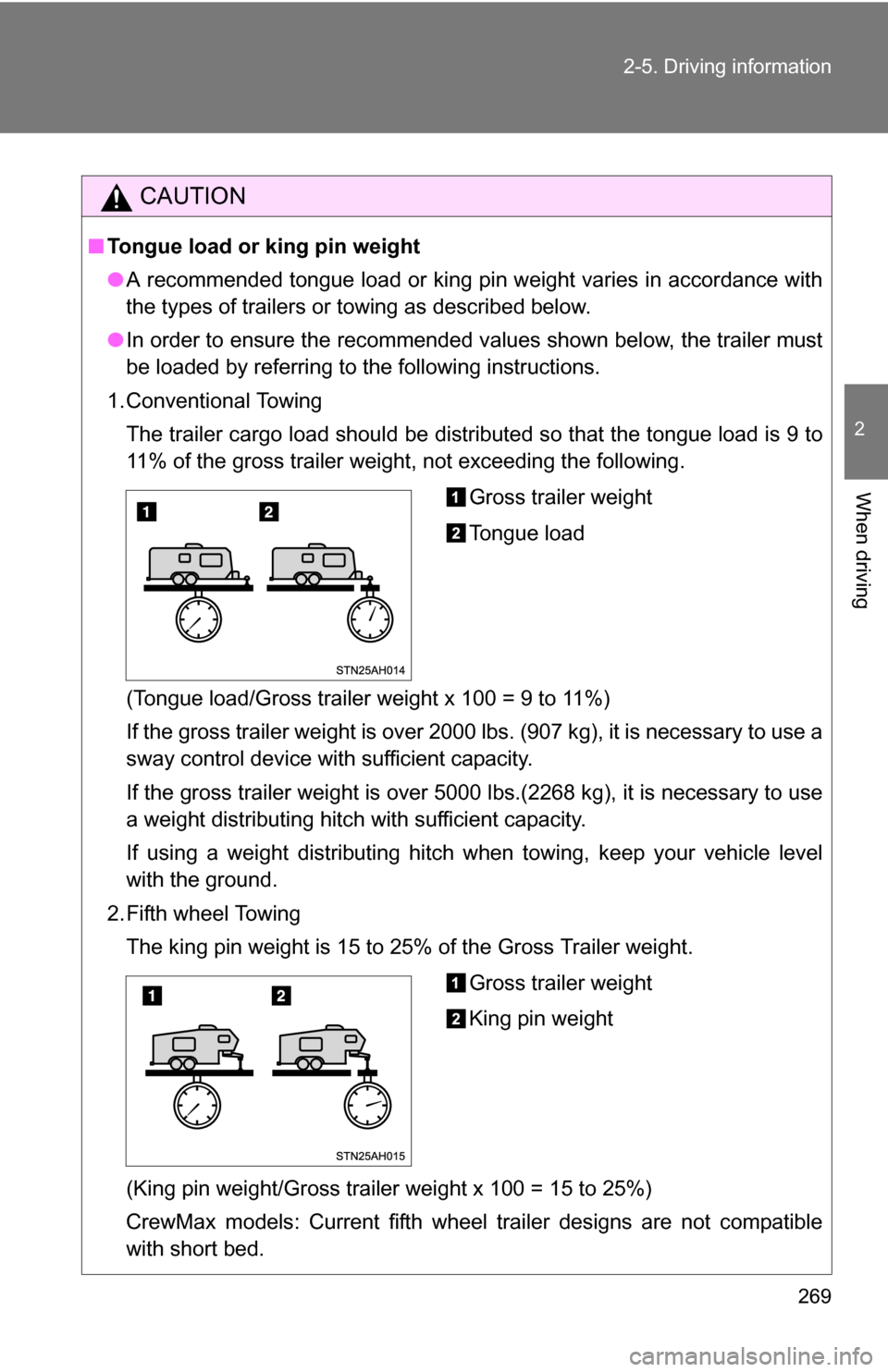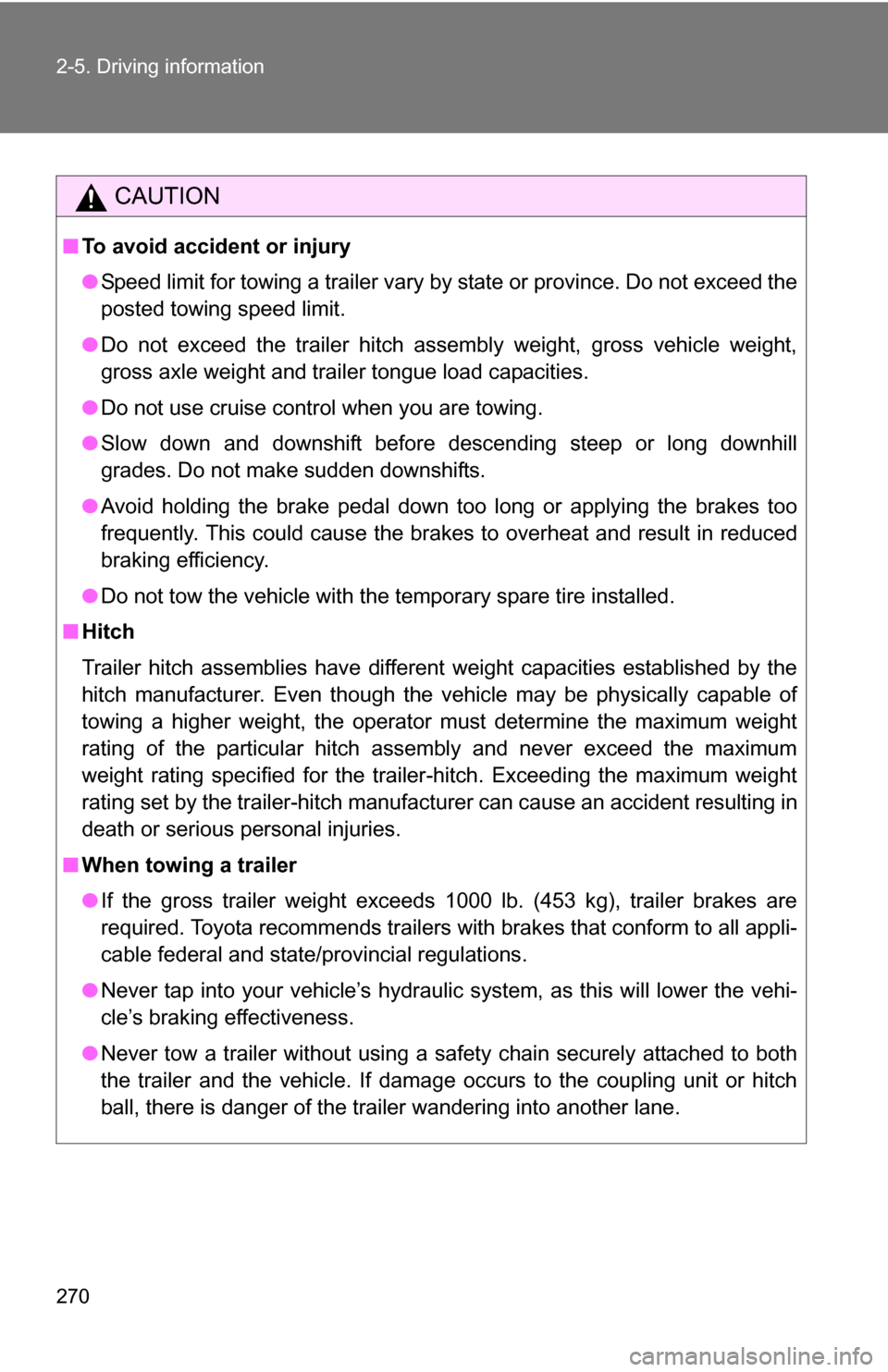Page 259 of 672

259
2-5. Driving information
2
When driving
Trailer tongue load
● A recommended tongue load or king pin weight varies in accor-
dance with the types of trailers or towing as described below.
● In order to ensure the recommended values shown below, the
trailer must be loaded by referring to the following instructions.
1. Conventional Towing
The trailer cargo load should be distributed so that the tongue
load is 9 to 11% of the gross trailer weight, not exceeding the fol-
lowing.
(Tongue load /Gross trailer weight x 100 = 9 to 11%)
If the gross trailer weight is over 2000 lbs. (907 kg), it is neces-
sary to use a sway control device with sufficient capacity.
If the gross trailer weight is over 5000 lbs. (2268 kg), it is neces-
sary to use a weight distributing hitch with sufficient capacity.
If using a weight distributing hi tch when towing, keep your vehi-
cle level with the ground.
Towing related termMeaning
Towing capacity
The maximum allowable gross trailer weight.
Towing capacity is calculated considering base
vehicle with necessary vehicle equipment and
150 pound driver.
Additional optional equipment, passengers and
cargo in the vehicle will reduce the towing
capacity, gross trailer weight includes the
trailer, cargo and necessary equipment for
towing.
Tongue loadThe load placed on the trailer hitch ball.
King pin weightThe load placed on the fifth wheel trailer hitch
mount.
Page 260 of 672
260 2-5. Driving information
Gross trailer weight
Tongue load
2. Fifth wheel Towing The king pin weight is 15 to 25% of the Gross Trailer weight.
(King pin weight/Gross trailer weight x 100 = 15 to 25%)
CrewMax models: Current fifth wheel trailer designs are not
compatible with short bed.
The gross trailer weight and tongue load can be measured with
platform scales found at a high way weighing station, building
supply company, trucking company, junk yard, etc.
Gross trailer weight
King pin weight
Page 261 of 672
261
2-5. Driving information
2
When driving
Hitch
● If you wish to install a trailer hitch, contact your Toyota dealer.
● Use only a hitch that conforms to the gross trailer weight require-
ment.
● Follow the directions supplied by the hitch manufacturer.
● Lubricate the hitch ball and king pin with a light coat of grease.
● Remove the trailer hitch whenever you are not towing a trailer.
After removing the hitch, seal any mounting hole in the vehicle
body to prevent entry of any substances into the vehicle.
Bumper towing (vehicles with steel bumper only)
The rear bumper of your vehicle
is equipped with a hole to install
a trailer ball.
The maximum gross trailer
weight: 5000 lb. (2268 kg)
The gross trailer weight (trailer
weight plus cargo weight) when
towing with the bumper must
never exceed 5000 lb. (2268 kg).
Page 262 of 672
262 2-5. Driving information
Selecting trailer ballUse the correct trailer ball for your application. Trailer ball load rating
Matches or exceeds the gross
trailer weight rating of the trailer.
Ball diameter
Matches the size of the trailer
coupler. Most couplers are
stamped with the required trailer
ball size.
Shank length
Protrudes beyond the bottom of
the lock washer and nut at least 2
threads.
Shank diameter
Matches the ball mount hole
diameter size.
Trailer
classTypical trailer ball
size
IV2 5/16 in.
II and III2 in.
I1 7/8 in.
Page 268 of 672

268 2-5. Driving information
■Maintenance
●If you tow a trailer, your vehicle will require more frequent maintenance
due to the additional load. (See “Scheduled Maintenance Guide” or
“Owner’s Manual Supplement”.)
● Retighten the fixing bolts of the towing ball and bracket after approxi-
mately 600 miles (1000 km).
CAUTION
■Trailer towing precautions
To tow a trailer safely, use extreme care and drive the vehicle in accordance
with the trailer’s characteristics and operating conditions.
The vehicle stability and braking performance are affected by trailer stability,
brake setting and performance, and the hitch.
Follow all the instructions described in this section. Failure to do so could
cause an accident resulting in death or serious injury.
■ Weight limit precautions
●The gross trailer weight must never exceed towing capacity. ( P. 251)
● The gross combination weight must never exceed the GCWR. ( P. 251)
● Exceeding the towing capacity, GVWR, GCWR or GAWR can cause an
accident resulting in death or serious injuries.
●The gross vehicle weight must never
exceed the GVWR indicated the Certifi-
cation Label.
● The gross axle weight on each axle
must never exceed the GAWR indi-
cated the Certification Label.
Page 269 of 672

269
2-5. Driving information
2
When driving
CAUTION
■
Tongue load or king pin weight
●A recommended tongue load or king pin weight varies in accordance with
the types of trailers or towing as described below.
● In order to ensure the recommended values shown below, the trailer must
be loaded by referring to the following instructions.
1. Conventional Towing The trailer cargo load should be distributed so that the tongue load is 9 to
11% of the gross trailer weight, not exceeding the following.
(Tongue load/Gross trailer weight x 100 = 9 to 11%)
If the gross trailer weight is over 2000 lbs. (907 kg), it is necessary to use a
sway control device with sufficient capacity.
If the gross trailer weight is over 5000 lbs.(2268 kg), it is necessary to use
a weight distributing hitch with sufficient capacity.
If using a weight distributing hitch when towing, keep your vehicle level
with the ground.
2. Fifth wheel Towing The king pin weight is 15 to 25% of the Gross Trailer weight.
(King pin weight/Gross trailer weight x 100 = 15 to 25%)
CrewMax models: Current fifth wheel trailer designs are not compatible
with short bed.
Gross trailer weight
Tongue load
Gross trailer weight
King pin weight
Page 270 of 672

270 2-5. Driving information
CAUTION
■To avoid accident or injury
●Speed limit for towing a trailer vary by state or province. Do not exceed the
posted towing speed limit.
● Do not exceed the trailer hitch assembly weight, gross vehicle weight,
gross axle weight and trailer tongue load capacities.
● Do not use cruise control when you are towing.
● Slow down and downshift before descending steep or long downhill
grades. Do not make sudden downshifts.
● Avoid holding the brake pedal down too long or applying the brakes too
frequently. This could cause the brakes to overheat and result in reduced
braking efficiency.
● Do not tow the vehicle with the temporary spare tire installed.
■ Hitch
Trailer hitch assemblies have different weight capacities established by the
hitch manufacturer. Even though the vehicle may be physically capable of
towing a higher weight, the operator must determine the maximum weight
rating of the particular hitch assembly and never exceed the maximum
weight rating specified for the trailer-hitch. Exceeding the maximum weight
rating set by the trailer-hitch manufacturer can cause an accident resulting in
death or serious personal injuries.
■ When towing a trailer
●If the gross trailer weight exceeds 1000 lb. (453 kg), trailer brakes are
required. Toyota recommends trailers with brakes that conform to all appli-
cable federal and state/provincial regulations.
● Never tap into your vehicle’s hydraulic system, as this will lower the vehi-
cle’s braking effectiveness.
● Never tow a trailer without using a safety chain securely attached to both
the trailer and the vehicle. If damage occurs to the coupling unit or hitch
ball, there is danger of the trailer wandering into another lane.
Page 443 of 672
443
3-7. Other interior features
3
Interior and exterior features
CAUTION
■
Burns
●Use caution when seating the following persons in a seat with the seat
heater on to avoid the possibility of burns:
• Babies, small children, the elderly, the sick and the disabled
• Persons with sensitive skin
• Persons who are fatigued
• Persons who have taken alcohol or drugs that induce sleep (sleeping
drugs, cold remedies, etc.)
● Do not cover the seat with anything when using the seat heater.
Using the seat heater with a blanket or cushion increases the temperature
of the seat and may lead to overheating.
NOTICE
■To prevent seat heater damage
Do not put unevenly weighted objects on the seat and do not stick sharp
objects (needles, nails, etc.) into the seat.
■ To prevent battery discharge
Turn the switches off when the engine is not running.